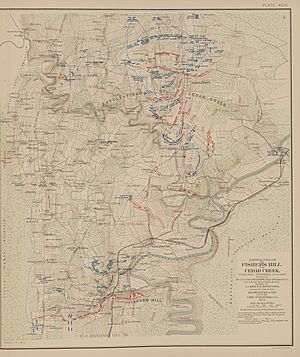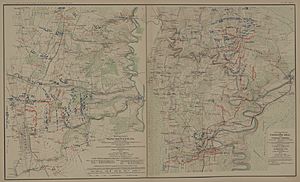Battle of Fisher's Hill facts for kids
Quick facts for kids Battle of Fisher's Hill |
|||||||
|---|---|---|---|---|---|---|---|
| Part of the American Civil War | |||||||
 Battlefields of Fisher's Hill and Cedar Creek, VA |
|||||||
|
|||||||
| Belligerents | |||||||
| Commanders and leaders | |||||||
| Philip H. Sheridan | Jubal Early | ||||||
| Units involved | |||||||
| Army of the Shenandoah | Army of the Valley | ||||||
| Strength | |||||||
| ~35,000 ("present for duty") 29,444 (engaged) |
9,500 | ||||||
| Casualties and losses | |||||||
| 528 | 1,234 | ||||||
The Battle of Fisher's Hill was a big fight during the American Civil War. It happened on September 21–22, 1864. The battle took place near Strasburg, Virginia. It was part of the Valley Campaigns of 1864.
Even though the Confederate army had a very strong defensive spot, they lost the battle. The Confederate army was led by General Jubal Early. They were defeated by the Union Army of the Shenandoah. This Union army was commanded by General Philip Sheridan.
Contents
Why the Battle Happened
The Armies Get Ready
The year 1864 was a busy time in the Shenandoah Valley. This area was very important during the Civil War. General Philip Sheridan led the Union forces. He had about 35,000 soldiers ready to fight. General Jubal Early led the Confederate forces. He had fewer men, just under 10,000 soldiers.
After a battle called the Third Battle of Winchester, Early's army moved. They took up a very strong defensive position. Their right side was protected by the North Branch of the Shenandoah River. The left side of their foot soldiers was on a place called Fisher's Hill. Confederate horse soldiers (cavalry) were supposed to guard the area from Fisher's Hill to Little North Mountain.
General George Crook was a Union commander. He suggested a clever plan to Sheridan. Crook thought they should attack the side of the Confederate position. This is called "flanking" an enemy. Crook's soldiers were given the job to move through the woods. They would go along the mountain slopes. Their goal was to surprise and attack the Confederate cavalry.
The Battle Begins

General Crook's surprise attack started around 4 p.m. on September 22, 1864. His foot soldiers quickly pushed the Confederate horse soldiers out of the way. A Confederate general named Stephen Dodson Ramseur tried to turn his soldiers to face the new threat. But it was too late.
Crook's soldiers, along with General James B. Ricketts's division, hit Ramseur's line hard. They broke through the Confederate defenses. Other Union divisions also joined in the attack. The Southern battle line could not hold. It broke apart, and the Confederate soldiers had to retreat.
What Happened Next
After the battle, the Confederate soldiers fell back. They moved to a town called Waynesboro, Virginia. The Union army tried to stop their retreat. General Alfred Thomas Archimedes Torbert was sent with 6,000 horse soldiers. He was supposed to go through a valley called Luray Valley. His mission was to get behind Early's army. He wanted to cut off their escape route at Fisher's Hill.
However, Torbert only made a small effort against the 1,200 Confederate horse soldiers. These Confederates were led by General Williams Carter Wickham. Torbert's attack at a place called Milford (now Overall) was not strong enough. Because of this, General Early and his army managed to escape.
Five Union soldiers were recognized for their bravery at Fisher's Hill. They received the Medal of Honor. This is the highest award for military bravery in the United States.
- Private James Connors, 43rd New York Infantry
- Private John Creed, 23rd Illinois Infantry
- Private George G. Moore, 11th West Virginia Infantry
- Sergeant Sylvester D. Rhodes, 61st Pennsylvania Infantry
- First Lieutenant Edward N. Whittier, 5th Battery Maine Light Artillery
Saving the Battlefield
Today, parts of the Fisher's Hill battlefield are preserved. The Civil War Trust (which is now part of the American Battlefield Trust) has helped save over 362 acres of this important historical site. There are trails and signs on the preserved land. These help visitors learn about the battle and what happened there.


